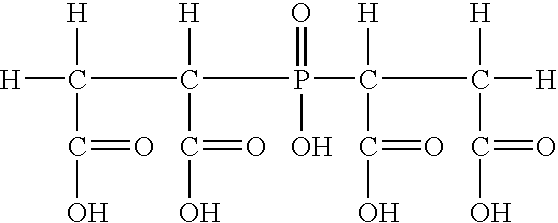Compositions and methods for inhibiting corrosion in aqueous media
- Summary
- Abstract
- Description
- Claims
- Application Information
AI Technical Summary
Benefits of technology
Problems solved by technology
Method used
Image
Examples
example 1
Experimental Treatments
[0033]Al 0.5—Effect on Saccharic Acid (SA) Concentration
[0034]Ca 250, Mg 100, Malk 175, 4 Dispersant I, 8 PESA, 0.6 PO4
[0035]PESA=polyepoxysuccinic acid; Dispersant I=acrylic acid / allyl hydroxy propyl sulfonate ether copolymer (AA / AHPSE)—U.S. Pat. No. 4,717,499.
[0036]Data in Example 1 show how the addition of 0.5 Al to different concentrations of Saccharic acid significantly reduces the corrosion rate and improves the appearance of the metal surface. In this specific example, acceptable performance is achieved at SA / Al=20 / 0.5 combinations. In absence of Al, 30 ppm of Saccharic acid is needed to achieve acceptable performance.
TABLE 1Impact of Al on Saccharic AcidActivesActivesppmppmcorrosion rateappearance[SA][Al](mpy)rating1.1150.03.9071.2150.52.7211.3200.02.6341.4200.50.6211.5300.00.8611.6300.50.410
example 2
[0037]Al and Mn—Effect on Saccharic Acid (SA) Concentration
[0038]Ca 400, Mg 150, SiO2 30, Malk 200, 4-8 (Dispersant I or II), 8 PESA, 1 PO4.
[0039]Dispersant II=acrylic acid / ammonium allyl polyethoxy sulfate copolymer (AA / APES)—U.S. Pat. No. 7,094,852.
[0040]Data in Table 2 show how the addition of low concentrations of Al and Mn affect the concentration of saccharic acid needed to provide acceptable performance. Under these experimental conditions in this specific example, acceptable performance is achieved at SA / Al=25 / 0.25 and SA / Mn=25 / 05 combinations. In absence of divalent metal ions like Al or Mn, 35 ppm of saccharic acid is needed to achieve acceptable performance.
TABLE 2Impact of Al and Mn on Saccharic AcidActivesActivesActivesppmppmppmcorrosion rateappearance[SA][Al][Mn](mpy)rating2.1250.000.001.7332.2350.000.000.7202.3250.250.001.3902.4250.500.000.7302.5250.000.501.0002.6250.002.000.470
example 3
[0041]Al—Effect on Different Hydroxy Acids
[0042]Ca 400, Mg 150, SiO2 30, Malk 200, 4-8 (Dispersant I or III), 8 PESA.
[0043]Dispersant III=acrylic acid / allyl hydroxy propyl sulfonate ether / ammonium allyl polyethoxy sulfate terpolymer (AA / AHPSE / APES)—U.S. Pat. No. 7,094,852.
[0044]Data in Table 3 show how the addition of divalent metal ions impacts the concentration of hydroxyacids needed to provide acceptable performance.
[0045]Examples 3—1-3—5 in Table 3 show that excellent performance can be achieved with 100 ppm of poly (epoxy succinic acid) of low degree of polymerization (DP 2-3). The use of 0.5 ppm Al can reduce the carbon footprint of this material to 25 ppm, a 75 % reduction in carbon footprint contribution.
[0046]Examples 3—6-3—12 for p-Xylylene-HSA (pX-HSA) in Table 3 show excellent performance can be obtained at 80 ppm. Alternatively, excellent performance can be obtained for pX-HSA / Al=20 / 1 or 10 / 2, i.e., a 75-88% reduction in carbon footprint contribution. Examples 3—13-3—15...
PUM
| Property | Measurement | Unit |
|---|---|---|
| Fraction | aaaaa | aaaaa |
| Fraction | aaaaa | aaaaa |
| Fraction | aaaaa | aaaaa |
Abstract
Description
Claims
Application Information
 Login to View More
Login to View More - R&D
- Intellectual Property
- Life Sciences
- Materials
- Tech Scout
- Unparalleled Data Quality
- Higher Quality Content
- 60% Fewer Hallucinations
Browse by: Latest US Patents, China's latest patents, Technical Efficacy Thesaurus, Application Domain, Technology Topic, Popular Technical Reports.
© 2025 PatSnap. All rights reserved.Legal|Privacy policy|Modern Slavery Act Transparency Statement|Sitemap|About US| Contact US: help@patsnap.com



